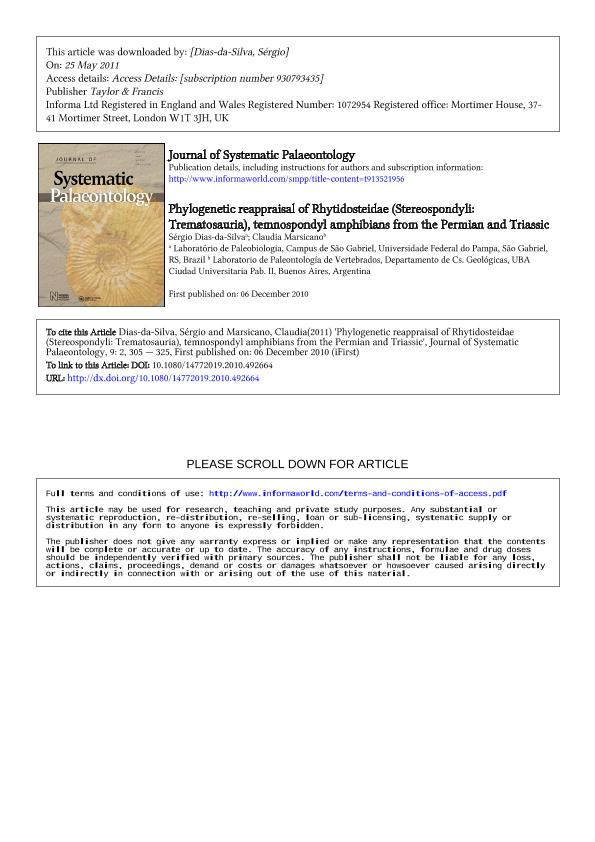Mostrar el registro sencillo del ítem
dc.contributor.author
Dias Da Silva, Sérgio
dc.contributor.author
Marsicano, Claudia Alicia

dc.date.available
2019-01-23T18:46:02Z
dc.date.issued
2011-06
dc.identifier.citation
Dias Da Silva, Sérgio; Marsicano, Claudia Alicia; Phylogenetic reappraisal of Rhytidosteidae (Stereospondyli: Trematosauria), temnospondyl amphibians from the Permian and Triassic; Taylor & Francis; Journal of Systematic Palaeontology; 9; 2; 6-2011; 305-325
dc.identifier.issn
1477-2019
dc.identifier.uri
http://hdl.handle.net/11336/68471
dc.description.abstract
All stereospondyl taxa previously placed within Rhytidosteidae are reviewed in a phylogenetic context. A parsimony analysis shows that Pneumatostega, Trucheosaurus, Rhytidosteus and Nanolania are placed outside Rhytidosteidae. If an implied weighting method is introduced in order to downweight homoplastic characters, then these taxa are placed within rhytidosteids (with the exception of Rhytidosteus), thus forming a resolved monophyletic group. This group is supported by four synapomorphies, including a twisted pterygoid quadrate ramus and sculpture consisting of a reticulate pattern with pustules or nodules at the junction between adjacent crests and ridges. Based on the topology of a majority rule consensus tree, we postulate a close relationship among all eastern Gondwanan rhytidosteids (Australian and Indian taxa) and among western Gondwanan taxa (South America, South Africa and Madagascar). Laurasian Boreopelta and Peltostega are successive paraphyletic taxa of both eastern and western groups. The Australian family 'Derwentiidae' is nested within Rhytidosteidae and is redefined as a subfamily (Derwentiinae nov.) which also includes Indobrachyops. Peltosteginae and Indobrachyopidae as currently defined in the literature are not supported. Rhytidosteinae is also not supported because Laidleria, Pneumatostega and Rhytidosteus do not emerge as a clade. The presence of the rhytidosteid Trucheosaurus major in the Late Permian of Australia suggests that rhytidosteids were already diversified at that time. Increasing efforts to collect Upper Permian and Lower Triassic rhytidosteids should help to improve stratigraphical, palaeogeographical and phylogenetic information regarding this widespread group of temnospondyls.
dc.format
application/pdf
dc.language.iso
eng
dc.publisher
Taylor & Francis

dc.rights
info:eu-repo/semantics/openAccess
dc.rights.uri
https://creativecommons.org/licenses/by-nc-sa/2.5/ar/
dc.subject
Early Triassic
dc.subject
Late Permian
dc.subject
Palaeobiogeography
dc.subject
Pangaea
dc.subject
Phylogeny
dc.subject
Temnospondyli
dc.subject.classification
Paleontología

dc.subject.classification
Ciencias de la Tierra y relacionadas con el Medio Ambiente

dc.subject.classification
CIENCIAS NATURALES Y EXACTAS

dc.title
Phylogenetic reappraisal of Rhytidosteidae (Stereospondyli: Trematosauria), temnospondyl amphibians from the Permian and Triassic
dc.type
info:eu-repo/semantics/article
dc.type
info:ar-repo/semantics/artículo
dc.type
info:eu-repo/semantics/publishedVersion
dc.date.updated
2019-01-23T17:04:07Z
dc.journal.volume
9
dc.journal.number
2
dc.journal.pagination
305-325
dc.journal.pais
Reino Unido

dc.description.fil
Fil: Dias Da Silva, Sérgio. Universidade Federal do Pampa; Brasil
dc.description.fil
Fil: Marsicano, Claudia Alicia. Consejo Nacional de Investigaciones Científicas y Técnicas. Oficina de Coordinación Administrativa Ciudad Universitaria. Instituto de Estudios Andinos "Don Pablo Groeber". Universidad de Buenos Aires. Facultad de Ciencias Exactas y Naturales. Instituto de Estudios Andinos "Don Pablo Groeber"; Argentina
dc.journal.title
Journal of Systematic Palaeontology

dc.relation.alternativeid
info:eu-repo/semantics/altIdentifier/doi/http://dx.doi.org/10.1080/14772019.2010.492664
dc.relation.alternativeid
info:eu-repo/semantics/altIdentifier/url/https://www.tandfonline.com/doi/abs/10.1080/14772019.2010.492664
Archivos asociados
